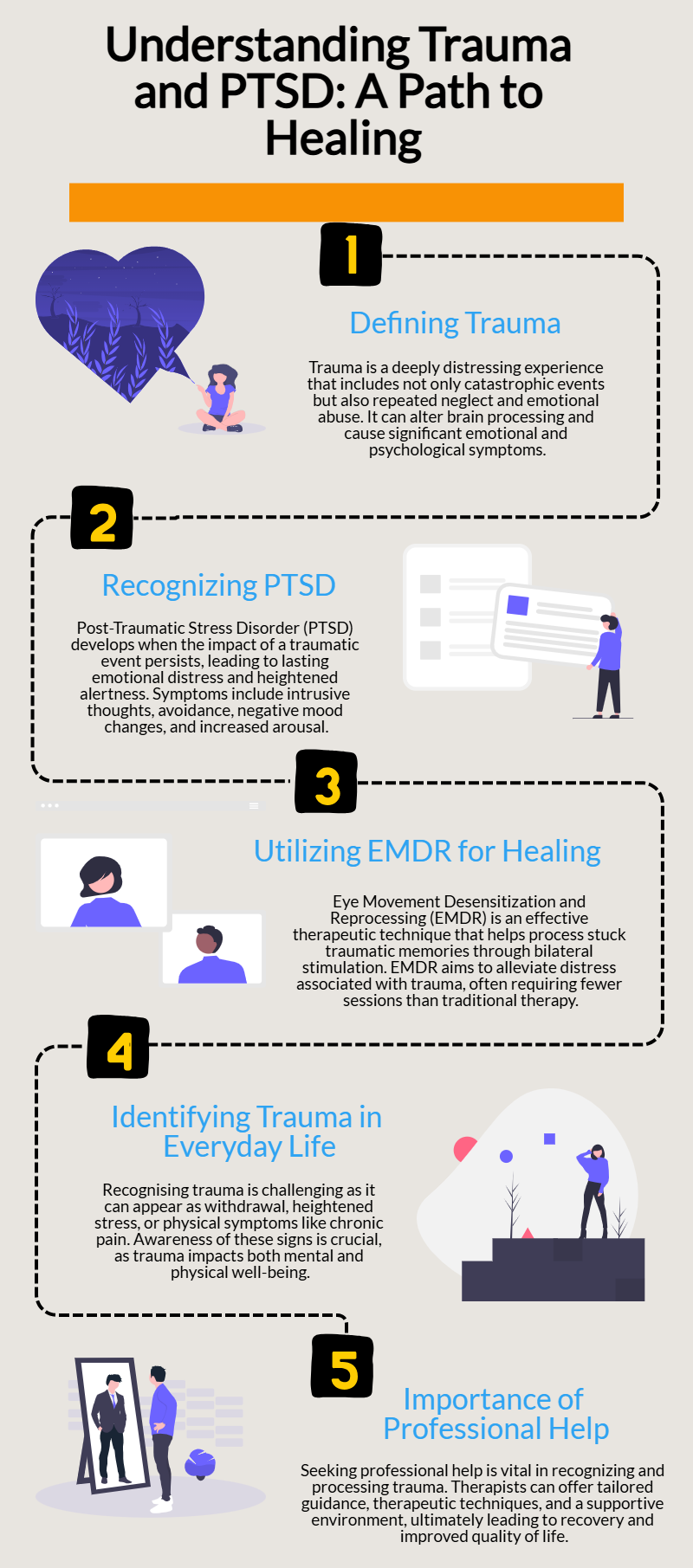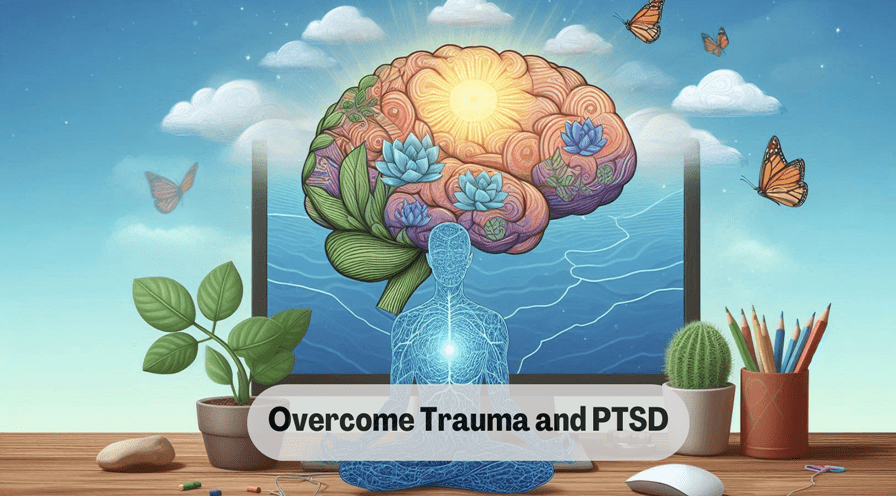The Signs and Stages of PTSD – How to Know if You Have PTSD
Trauma and PTSD (Post-Traumatic Stress Disorder) are topics that resonate deeply with many individuals, whether through personal experience or in support of someone they care about.
Understanding these complex and multifaceted issues is essential for promoting healing and awareness.
Trauma is not limited to any single event or experience; it can arise from a variety of situations, such as accidents, violence, natural disasters, or deeply distressing personal encounters. The resulting psychological and physical reactions can be profound and long-lasting.
Post-Traumatic Stress Disorder is one of the most significant potential outcomes of trauma. PTSD is a mental health condition triggered by experiencing or witnessing traumatic events, leading to symptoms that may include intrusive memories, severe anxiety, hypervigilance, and avoidance behaviours.
These reactions often interfere with daily life and well-being, making it crucial to identify, understand, and address them effectively.
Stages of PTSD
PTSD often unfolds in distinct stages, each with its own characteristics.
- Impact Stage: This initial phase occurs immediately after the traumatic event and can involve shock, denial, or intense emotional responses. Individuals may feel disoriented and unable to process what has happened.
- Avoidance Stage: During this stage, people might start to avoid reminders of the trauma, leading to social withdrawal, emotional numbing, and a sense of isolation.
- Hyperarousal Stage: Characterised by heightened anxiety, irritability, and a state of constant alertness. Sleep disturbances, exaggerated startle responses, and difficulty concentrating are common.
- Reintegration Stage: The individual begins to process the trauma, often with therapeutic support, and gradually reintegrates coping mechanisms to manage symptoms. This stage can lead to acceptance and growth but may be accompanied by setbacks.

How to Know if You Have PTSD: A Multiple Choice Test
Below is a brief self-assessment to help you understand whether you might be experiencing symptoms of PTSD. Please remember that this test is not a substitute for professional diagnosis.
- Do you frequently have nightmares or intrusive memories about a distressing event?
- A) Rarely
- B) Occasionally
- C) Often
- D) Almost always
- Do you avoid places, activities, or people that remind you of a traumatic experience?
- A) Not at all
- B) Sometimes
- C) Frequently
- D) Always
- Do you feel detached or estranged from others?
- A) No
- B) Occasionally
- C) Often
- D) Always
- Do you experience sudden feelings of anger or irritability?
- A) Rarely
- B) Occasionally
- C) Often
- D) Almost always
- Do you struggle with sleep disturbances or insomnia?
- A) Never
- B) Occasionally
- C) Frequently
- D) Almost always
- Do you feel hyper-alert or find yourself easily startled?
- A) No
- B) Occasionally
- C) Often
- D) Always
- Do you have difficulty concentrating or focusing on tasks?
- A) Rarely
- B) Sometimes
- C) Frequently
- D) Always
- Do you experience physical reactions (e.g., sweating, rapid heartbeat) when reminded of a traumatic event?
- A) Not at all
- B) Occasionally
- C) Frequently
- D) Always
- Do you avoid talking about the traumatic event?
- A) Not at all
- B) Sometimes
- C) Frequently
- D) Always
- Do you feel a sense of hopelessness or negative beliefs about yourself or the world?
- A) No
- B) Occasionally
- C) Often
- D) Always
Scoring: If you answered C or D to most questions, you might be experiencing symptoms of PTSD.
It is important to seek guidance from a qualified mental health professional for an accurate assessment and support.

What to Do If You Discover You Are Suffering from PTSD: Practical Steps Towards Healing
Asking the question ‘how to know if you have PTSD’ is the first step. Discovering that you are experiencing symptoms of Post-Traumatic Stress Disorder (PTSD) can be a challenging and overwhelming realisation.
Whether the trauma is recent or from years ago, the impact can be profound. However, acknowledging that you are struggling is the first, powerful step towards recovery.
It’s important to remember that healing is possible, and there are practical steps you can take to support yourself as you move forward.
1. Acknowledge and Accept Your Feelings
The first step in healing is recognising and accepting that you are experiencing PTSD. It’s normal to feel confused, scared, or even in denial, but self-compassion is key. Understand that your reactions are not a sign of weakness but a natural response to trauma. You’re not alone, and it’s okay to seek support.
2. Seek Professional Support
Reaching out to a trained therapist or mental health professional is crucial. Therapy options like Cognitive Behavioural Therapy (CBT), Eye Movement Desensitisation and Reprocessing (EMDR), or trauma-focused therapy can help you process and manage your symptoms.
3. Build a Support Network
Isolation can make PTSD symptoms worse. Connect with trusted friends, family members, or support groups who understand your journey. They also at some stage ‘how to know if you have PTSD?’
Talking to others who have experienced similar trauma can provide comfort and reduce feelings of isolation.
4. Establish a Routine
Creating a sense of structure in your day-to-day life can help combat the chaos that PTSD can bring. Start with small, manageable tasks, and gradually build up to larger ones.
Having a routine helps to ground you and provide a sense of control when everything else might feel unpredictable.

5. Practice Mindfulness and Relaxation Techniques
Mindfulness, journalling, deep breathing, and grounding techniques can help you stay present and manage overwhelming emotions. Practices like meditation, yoga, and progressive muscle relaxation can reduce stress and improve emotional regulation. If you need help with this, one of our downloads can help.
6. Take Care of Your Body
Your physical health directly impacts your mental wellbeing. Engage in regular exercise, eat nourishing foods, and get enough sleep. Simple activities like walking or stretching can help release stored tension and improve your mood.
7. Avoid Alcohol and Drugs
Using substances to numb emotional pain may provide temporary relief but can worsen PTSD symptoms in the long run. It’s important to avoid self-medicating, as this can prevent your healing process from moving forward.
8. Educate Yourself About PTSD
Understanding PTSD and its symptoms can empower you in your recovery journey. Knowing that your reactions are normal and that others experience similar struggles can help you feel more in control. See some of our books that can help.
9. Set Realistic Expectations for Healing
Healing from trauma is a gradual process, and recovery looks different for everyone. Be patient with yourself, celebrate small victories, and don’t rush your healing. Setbacks may occur, but they are a normal part of the journey.
10. Consider Our Overcome Trauma and PTSD Online Course
If you are looking for a structured, supportive way to heal, our Overcome Trauma and PTSD online course is designed to help answer the question ‘how to know if you have PTSD’ in depth. It will help you manage your symptoms, understand the emotional impact of trauma, and regain a sense of control.
This course provides practical tools and coping strategies that you can apply at your own pace, wherever you are in your journey.
Why Our Course Can Help:
- Comprehensive Learning: Gain insights into the causes of PTSD and effective techniques to manage it.
- Practical Tools: Learn strategies that you can incorporate into your daily life, including relaxation exercises, reflective journalling, and mindfulness techniques.
- Supportive Environment: Join a community of individuals who understand your experience, and access ongoing support.
- Expert Guidance: Our course is led by professionals with extensive experience in trauma recovery and PTSD.
Conclusion
Healing from PTSD is not an overnight process, but by taking proactive steps, you can gradually regain control over your life. Remember, there’s no “right” way to heal—what matters most is finding the path that works for you.
Whatever you choose to do, know that healing is within your reach, and you deserve a life of peace, hope, and growth.
If you’re ready to start your healing journey, consider joining our Overcome Trauma and PTSD course today. You don’t have to walk this path alone.
We’re here to help you every step of the way.
Dr Tom Barber is a #1 bestselling author, integrative and existential psychotherapist and coach, supervisor, researcher, speaker, and co-founder of Self Help School. His work has spanned nearing 30 years, in which he has focussed on helping people all over the world to improve their knowledge and understanding of their psychological worlds. Tom regularly delivers courses and lectures in the UK, USA, Canada, Mexico, and across Europe. In addition, he maintains a private therapy and coaching consultancy from his base in Essex, and online.


